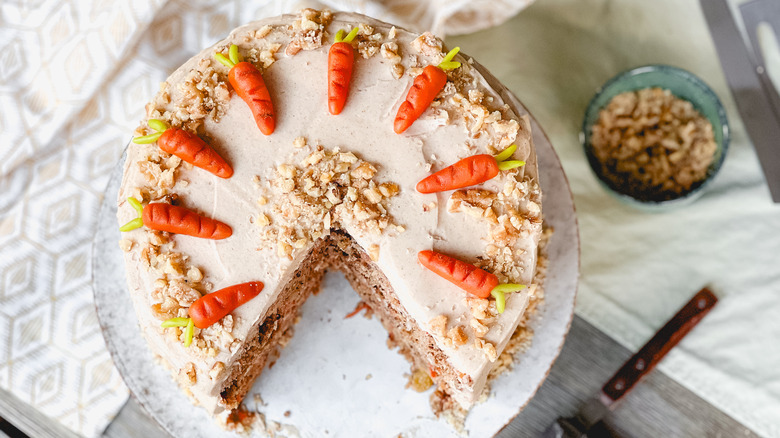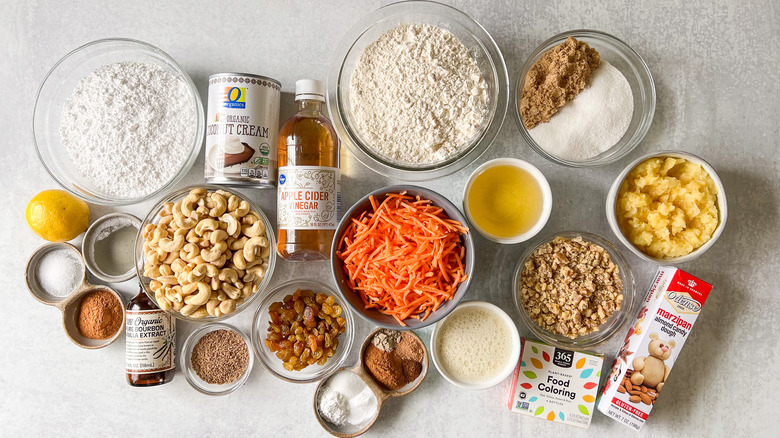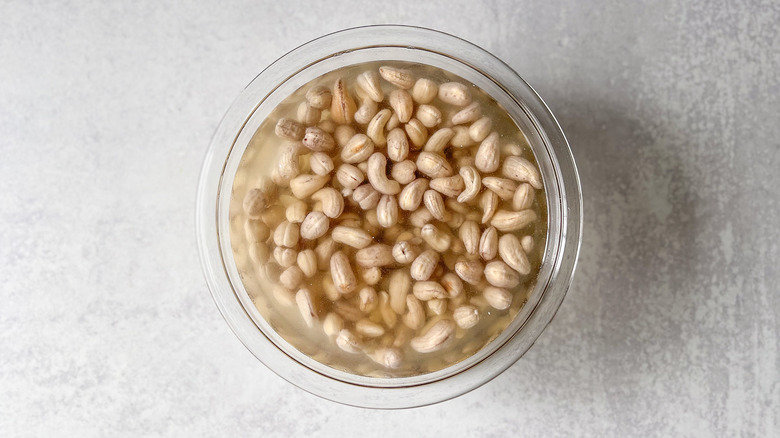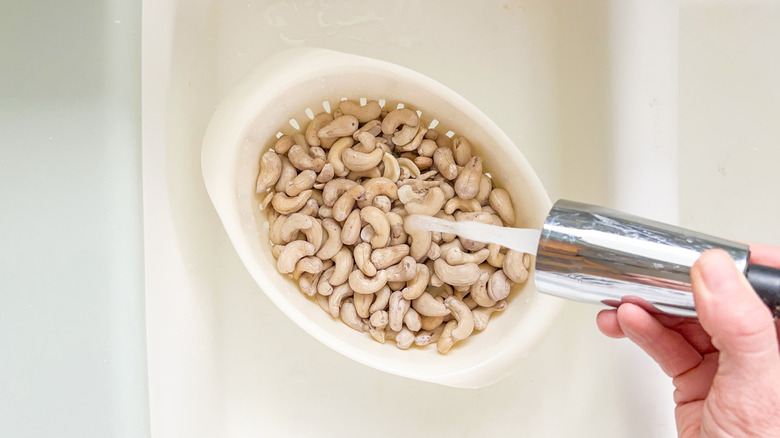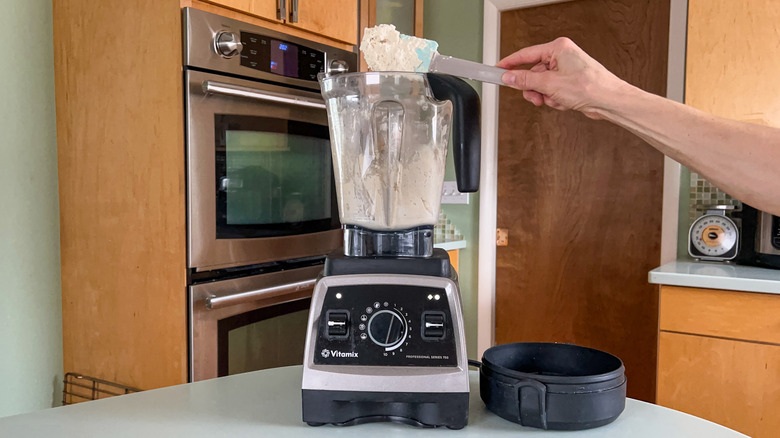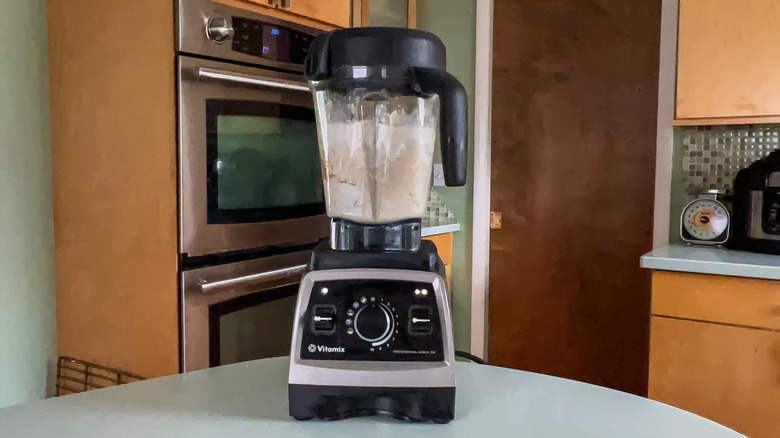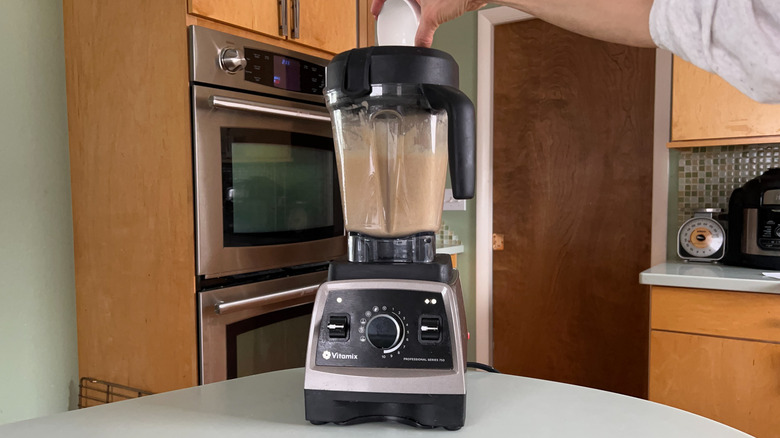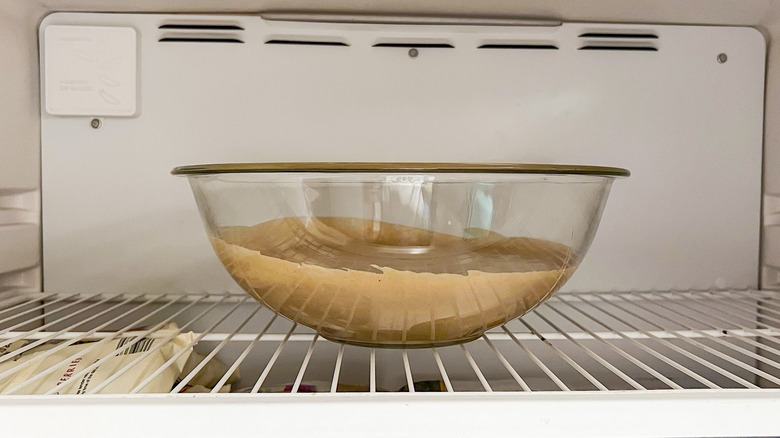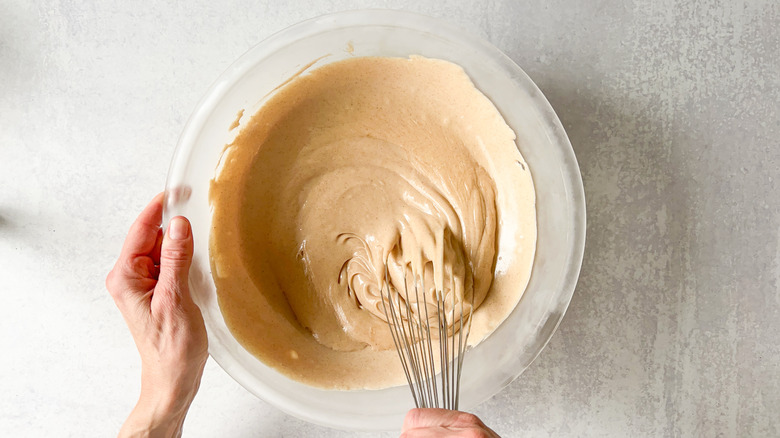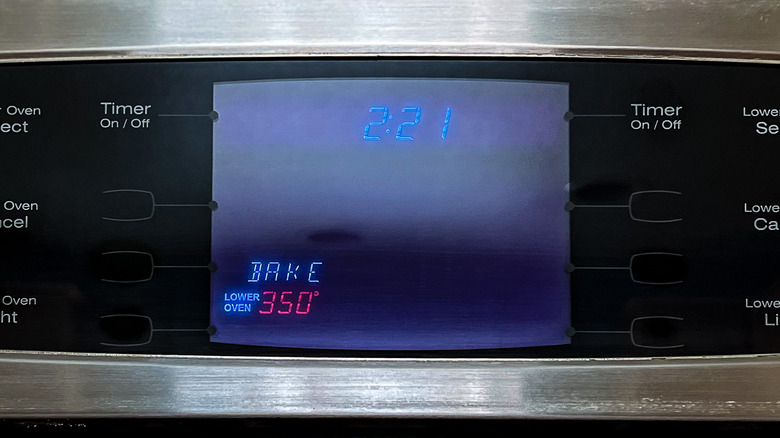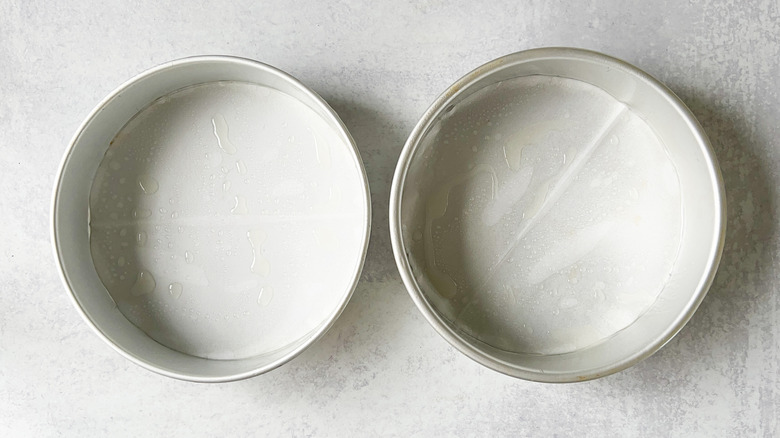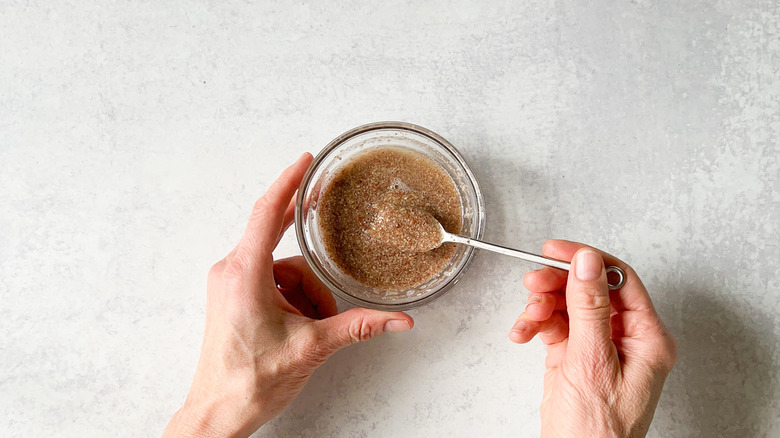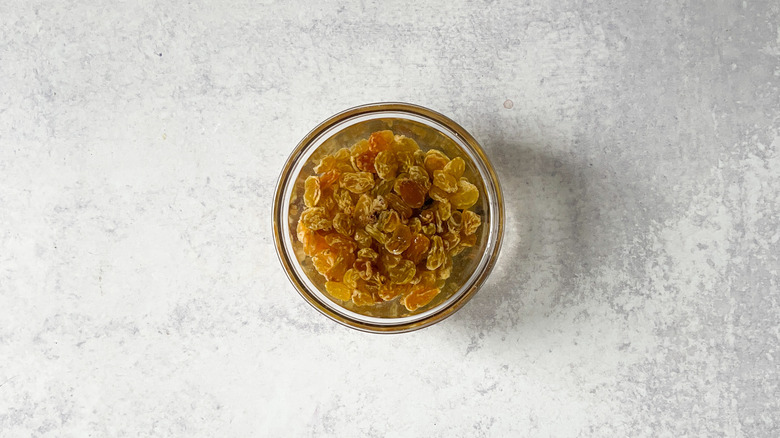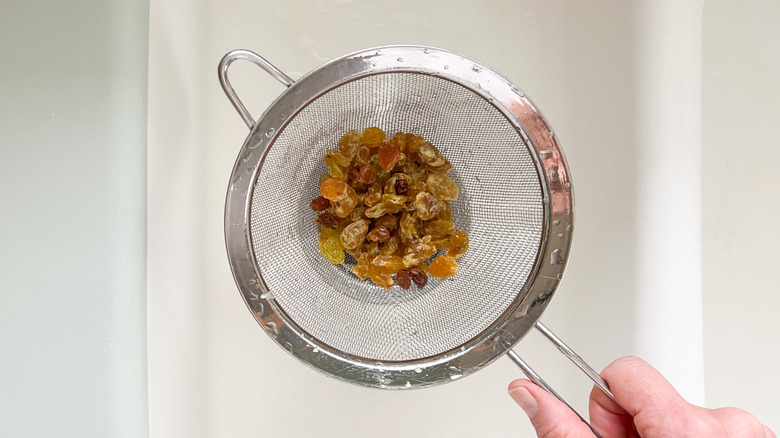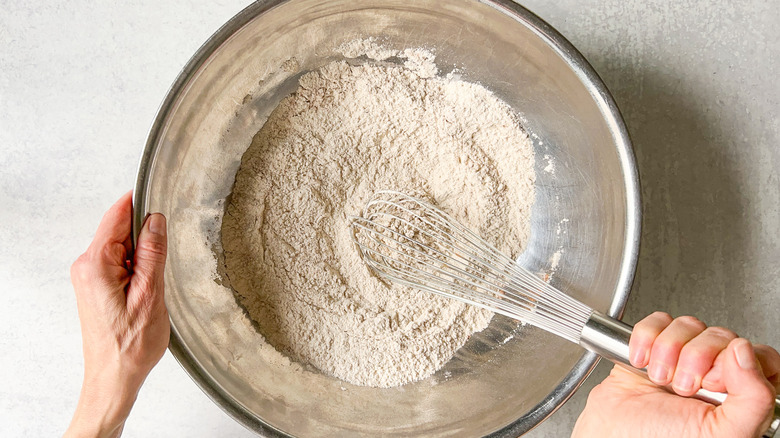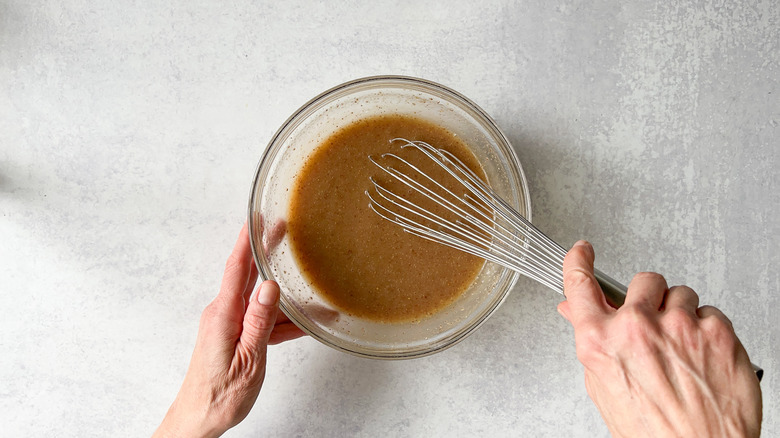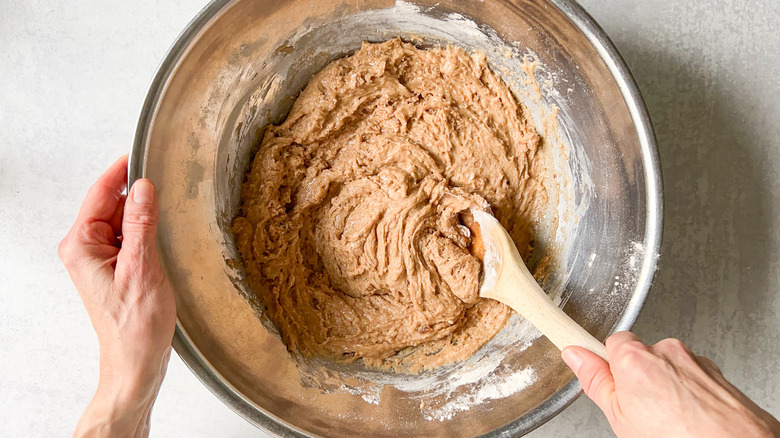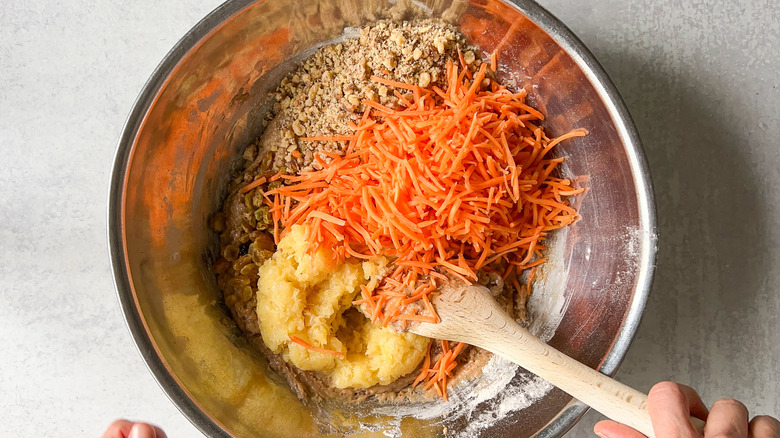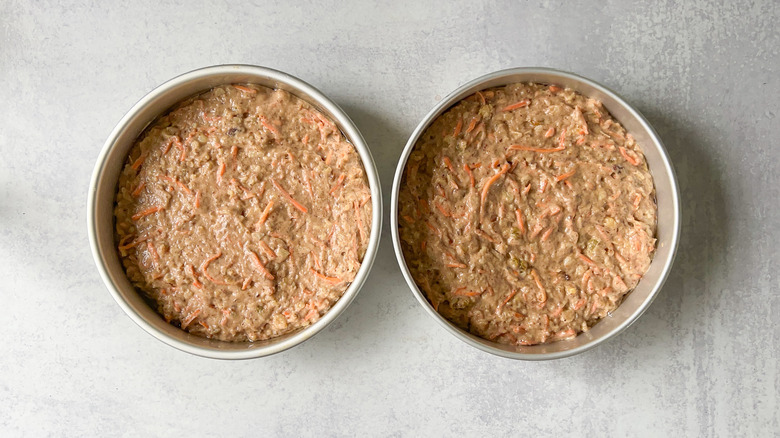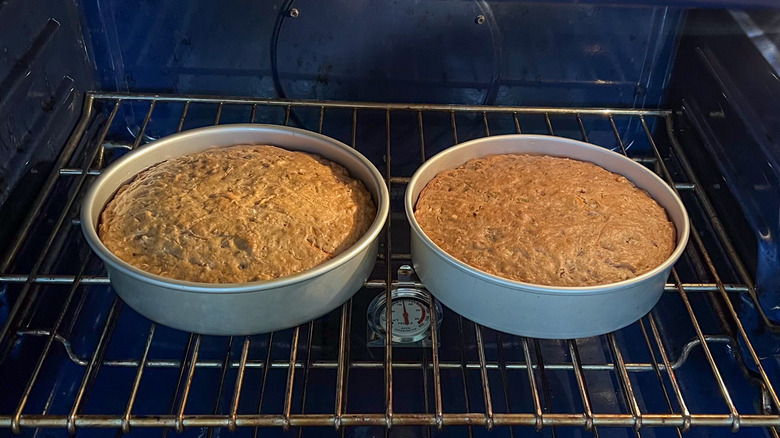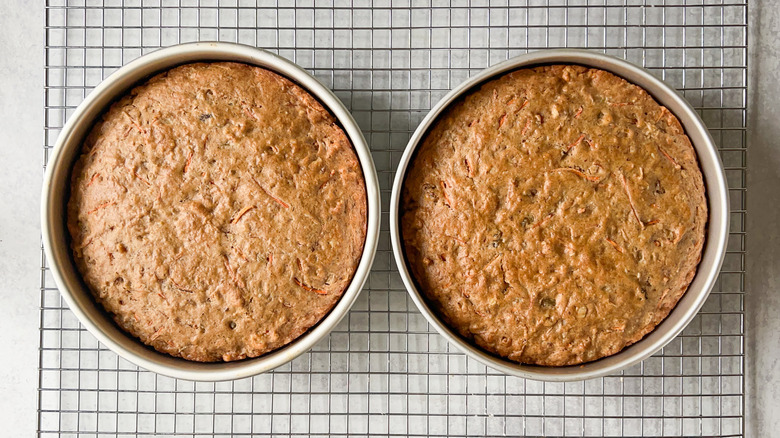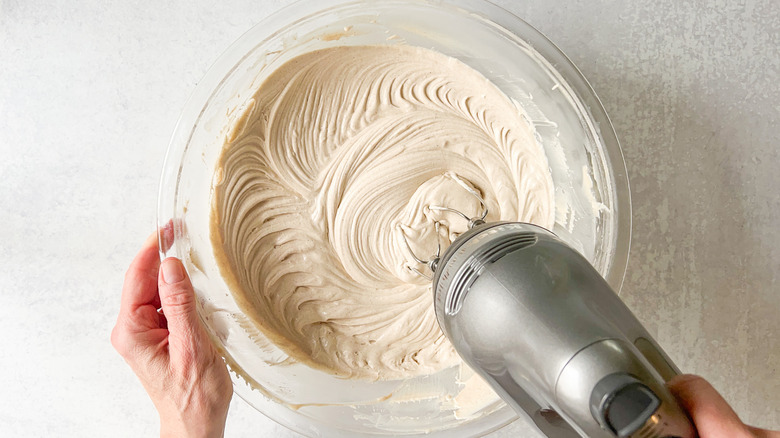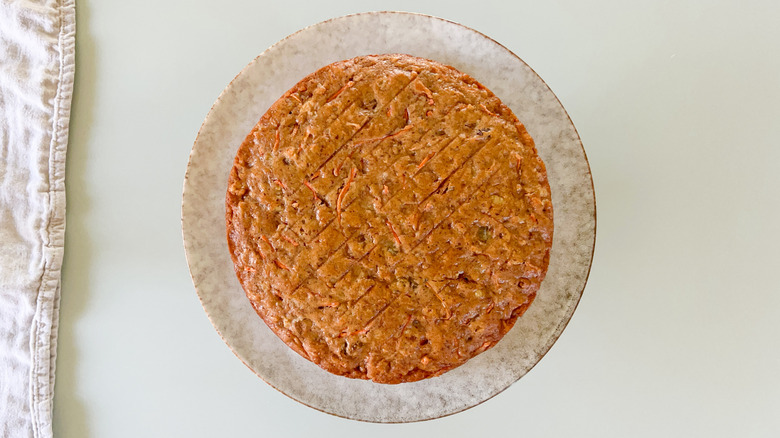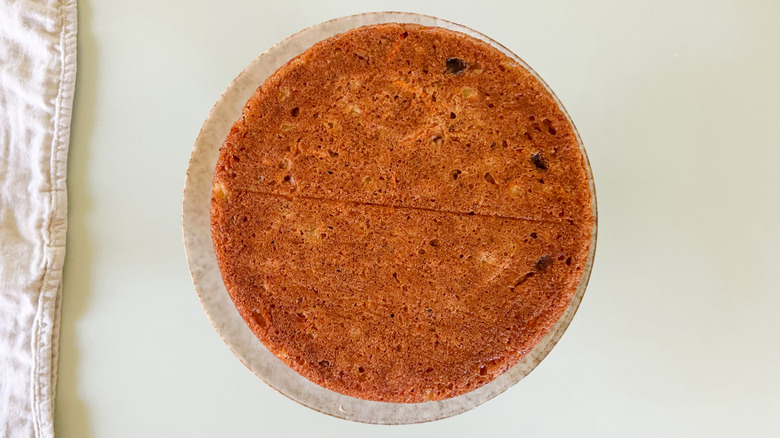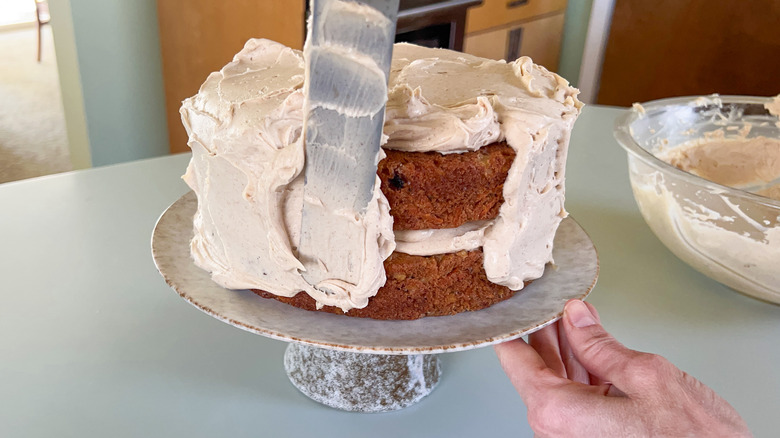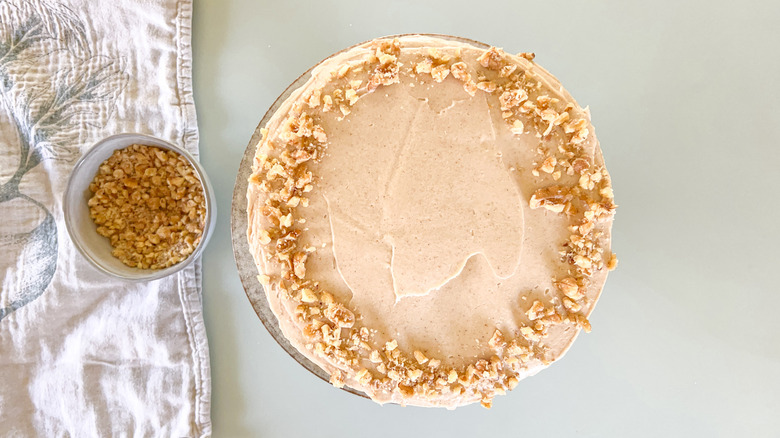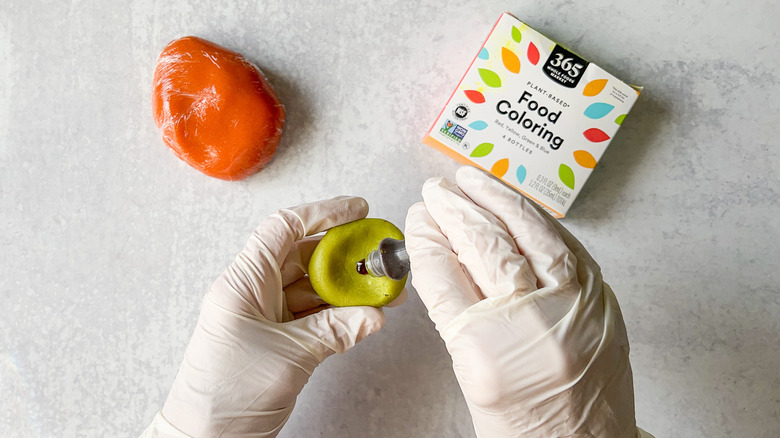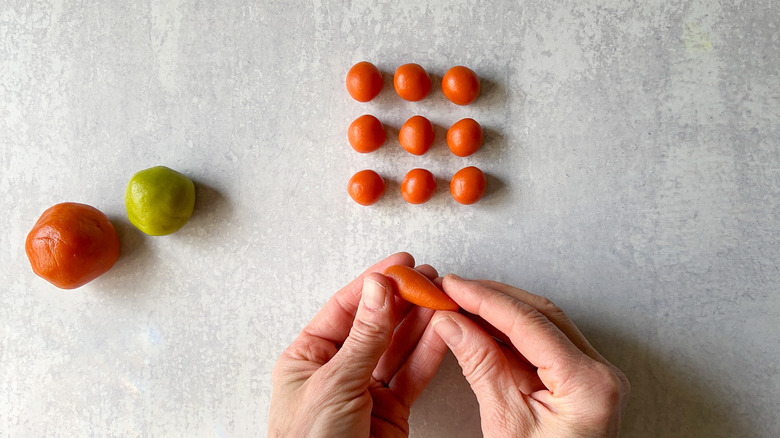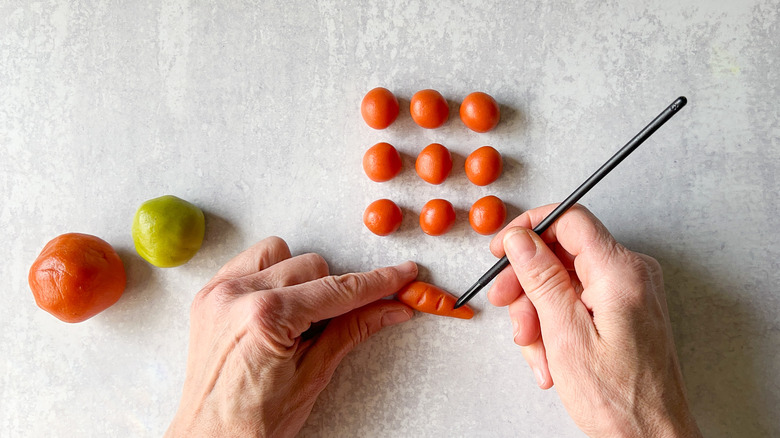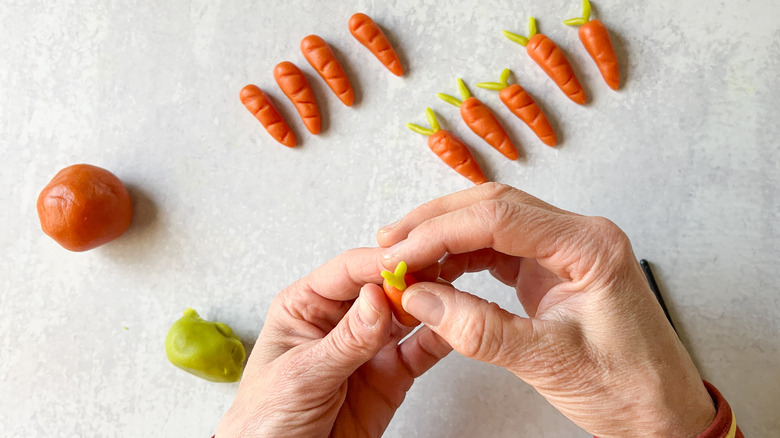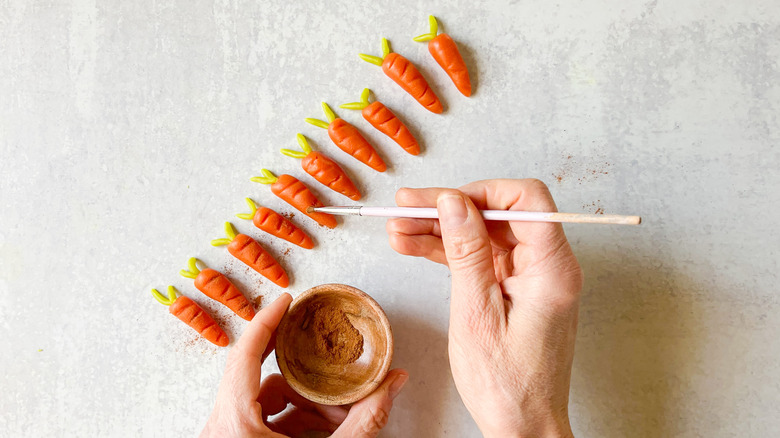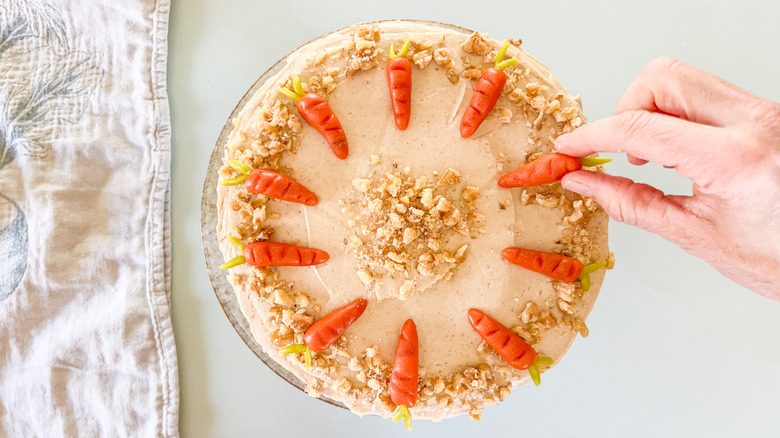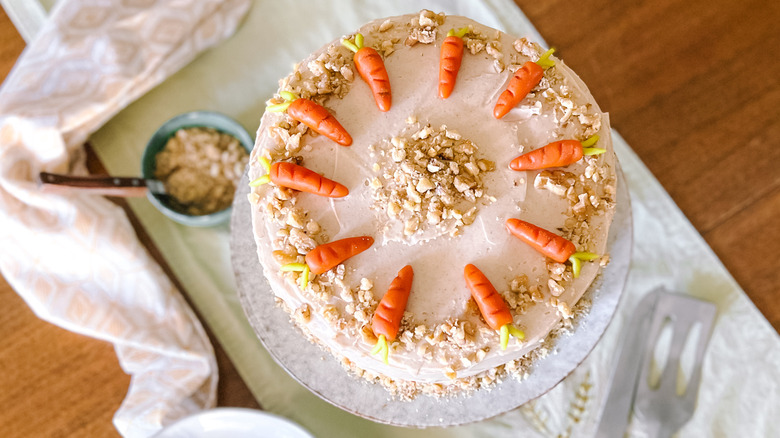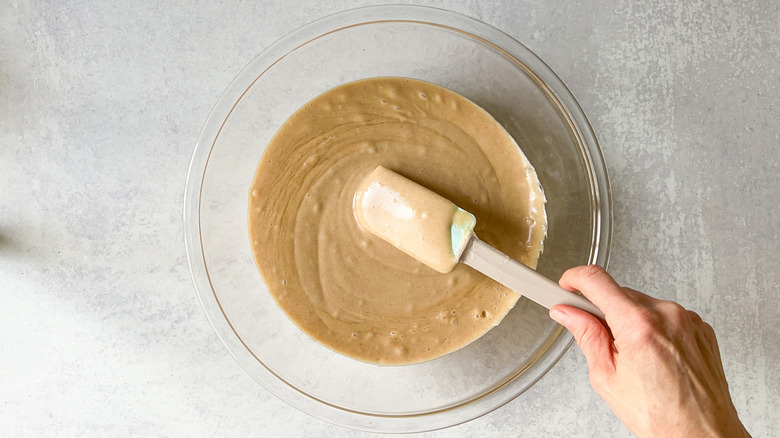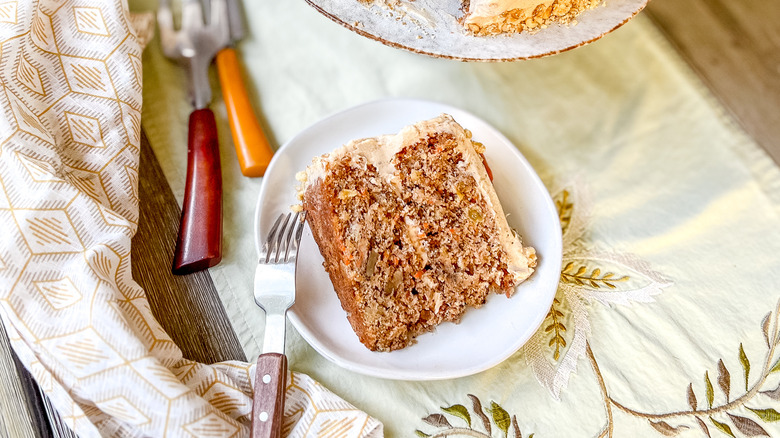Vegan Carrot Cake With Cinnamon-Cashew Frosting Recipe
Carrot cake is a beloved classic for good reason. It's moist, warmly spiced, full of texture, and wrapped in creamy goodness, and there are endless ways to customize it just to your liking. Recipe developer Julie Kinnaird's version of vegan carrot cake with cinnamon-cashew frosting takes the intimidation out of vegan baking and will leave you with a moist and fluffy carrot cake that can please anyone's taste. This cake gets its structure from a generous amount of shredded carrots and flax meal, which replace the eggs. Baking powder gives the layers a lift, along with the baking soda that reacts with the crushed pineapple. The batter is combined by hand to ensure that the cake's texture does not toughen from over-mixing. These layers rise and bake into golden, level layers that are easy to assemble with the creamy vegan frosting.
Soaked raw cashews form the base of the silky smooth cinnamon-cashew frosting, and they're pureed with coconut cream, confectioner's sugar, vanilla, and a bit of fresh lemon juice and apple cider vinegar to mimic the tanginess of traditional cream cheese icing. Virgin coconut oil adds extra richness and a hint of coconut flavor, which is warmed up with ground cinnamon. The icing takes a bit of time to chill and set up, but it is so worth it!
Gather the vegan carrot cake with cinnamon-cashew frosting ingredients
For the cake, you will need ground flaxseed, all-purpose flour, baking powder, baking soda, salt, ground cinnamon, cardamom, nutmeg, and cloves. These dry ingredients are moistened with canola (or other neutral-flavored) oil, unsweetened oat or almond milk, granulated and brown sugar, vanilla extract, and apple cider vinegar. Shredded carrots, crushed pineapple, chopped raw walnuts, and golden raisins add texture and structure to the cake. It's important that you finely shred the carrots so that they will cook quickly during baking. If you prefer a different nut, such as pecans or hazelnuts, feel free to substitute for the walnuts. Kinnaird likes the subtle flavor of the golden raisins in this recipe, but regular raisins will work just fine.
For the frosting, use raw, whole cashews for soaking. Roasted or salted cashews will not work for this recipe. Fresh lemon juice and apple cider vinegar add a tangy flavor reminiscent of cream cheese. Use full-fat coconut cream, as the fat helps the icing set up along with virgin coconut oil. Confectioners' sugar gives the frosting its sweetness, and ground cinnamon adds flavor and a bit of color.
Making marzipan carrots is optional, but these add such great visual appeal and whimsy! They're quite easy to make using a prepared roll of marzipan (make sure it is vegan-friendly and does not contain gelatin) and plant-based food coloring. Additional ground cinnamon is brushed on the finished carrots to give them a just-pulled-from-the-ground effect!
Step 1: Soak the cashews
Start the frosting 1 day in advance by placing the cashews in a large, heat-proof bowl and covering with hot water. Cover and soak the cashews for at least 8 hours and up to overnight.
Step 2: Drain and rinse the cashews
Drain and rinse the cashews.
Step 3: Process the cashews in a blender
Transfer the cashews to a high-speed blender or food processor along with the lemon juice, vanilla, and apple cider vinegar. Process until a paste forms.
Step 4: Add the coconut cream, confectioners' sugar, cinnamon, and salt to a blender
Add the coconut cream, confectioners' sugar, cinnamon, and salt. Process until completely smooth, scraping down the sides a few times (about 2 minutes total).
Step 5: Add the coconut oil
With the blender running, drizzle in the melted coconut oil and process until smooth.
Step 6: Chill the frosting
Pour the frosting into a large bowl and place in the freezer for 30 minutes.
Step 7: Whisk the frosting until smooth
Whisk the frosting smooth and freeze for an additional 30 minutes. Repeat the process 3 times in total.
Step 8: Preheat the oven
While you work on the frosting, preheat the oven to 350 F.
Step 9: Prepare the pans
Prepare two 8-inch round baking pans by coating the insides with baking spray and lining the bottoms with parchment circles.
Step 10: Mix the flaxmeal with water
Make the cake: In a small bowl, mix the ground flaxseed and warm water. Let sit for 10 minutes, until thickened.
Step 11: Soak the raisins
In a separate, medium bowl, cover the golden raisins with hot water and plump while the flaxseed meal is sitting.
Step 12: Drain the raisins
Drain the raisins and set aside.
Step 13: Whisk together the dry ingredients
In a large mixing bowl, whisk together the flour, baking powder, baking soda, salt, cinnamon, cardamom, nutmeg, and cloves.
Step 14: Whisk together the liquids, sugars, and flaxseed
In another mixing bowl, whisk together the canola oil, oat milk, granulated and brown sugar, vanilla, apple cider vinegar, and flaxseed mixture until smooth.
Step 15: Combine the dry and liquid ingredients
Stir the liquid mixture into the dry ingredients.
Step 16: Fold in the carrots, pineapple, walnuts, and raisins
Fold in the carrots, pineapple, walnuts, and plumped raisins, taking care not to overmix.
Step 17: Transfer the cake batter to the pans
Divide the batter evenly between the prepared pans.
Step 18: Bake the cakes
Bake the cakes for 35 minutes, or until golden brown and firm to the touch.
Step 19: Cool the cakes
Cool the cakes completely in the pans, then turn them out onto racks.
Step 20: Whip the frosting
Once the frosting has thickened and is very cold, use a hand mixer or stand mixer to whip until the frosting is light and thick.
Step 21: Place one cake on a platter
Place one cake layer on a plate or serving platter.
Step 22: Spread on some of the frosting
Spoon on about ¾ cup of frosting and evenly spread it to the edges.
Step 23: Place the second cake layer on top
Place the second cake layer on top of the frosting, bottom-side up.
Step 24: Finish frosting the cake
Spread on the remaining frosting to cover the top and all of the sides of the cake.
Step 25: Use remaining chopped walnuts as garnish
Use the additional chopped walnuts as a garnish.
Step 26: Color the marzipan for the carrots
To make the marzipan carrots, add a small amount of red and yellow food coloring to a golf ball–sized piece of marzipan, and knead to create an orange dough, wearing gloves, if desired.
Step 27: Make the green marzipan
Repeat the process with green food coloring and a smaller amount of marzipan to make a green dough for stems.
Step 28: Shape the orange marzipan into carrots
Roll small balls of orange dough about the size of a hazelnut, and then form them into a carrot shape.
Step 29: Add ridges to the carrots
Use a pick to create ridges in the dough and poke a hole at the top of the carrots to insert the stems.
Step 30: Shape the carrot stems
Roll thin pieces of the green dough into stem shapes and insert them into the holes in the carrot tops.
Step 31: Brush the carrots with cinnamon
Brush the carrots with a bit of cinnamon to simulate dirt.
Step 32: Place the carrots on the cake
Place the carrots decoratively around the top of the cake as a garnish.
Step 33: Serve the cake, and enjoy!
Keep the cake refrigerated until ready to slice and serve.
What are some tips and tricks for success with vegan baking and making vegan frosting?
Vegan baking can be challenging, especially replicating the textures and flavors of traditional baked goods. Kinnaird shares some tips for success that she has learned through years of experimenting with plant-based recipes. First, choose recipes that lend themselves to vegan substitutes. If you have a cake or cookie recipe that relies on a high percentage of eggs or butter, it might yield disappointment in the end. Instead, choose a recipe like this vegan carrot cake that has a variety of ingredients and a flavor and texture profile that allows for greater substitution.
Don't overmix your doughs or batters. Often, high-speed mixing for cakes or doughs is necessary for creating structure without eggs, but this kind of preparation can lead to tough textures without eggs. Flax eggs are a go-to egg substitute for Kinnaird. Learn to love flavors that come from different fats, such as nut butters and oils, flaxseed, refined coconut oil, and coconut cream. Keep your pantry well-stocked.
When making vegan frosting, experiment with ingredients other than vegan butter! Soaked nuts like the cashews in this recipe can deliver amazing results, as can almonds or macadamia nuts. Investing in a high-speed blender helps delivers a silky-smooth texture. The frosting in this recipe requires some patience. Multiple cooling, whisking, and high-speed whipping sessions may seem tedious, but this process allows the fat to hold better at room temperature and allows plenty of air to incorporate.
Can you make this vegan carrot cake gluten-free?
This vegan carrot cake recipe is easy to transform into a gluten-free treat. Choose a 1-to-1 gluten-free flour that can be directly substituted for all-purpose flour. Kinnaird says she loves baking with Cup4Cup's gluten-free flours, but be sure to use the wholemeal variety that does not contain milk powder. Because this vegan carrot cake recipe has ample ingredients to add moisture (carrots and crushed pineapple), no additional liquids are needed to accommodate the often absorbent nature of some gluten-free flours. Oat flour is another good option to try but will yield a slightly softer and more dense texture. While almond flour is a delicious ingredient in gluten-free baking, its high fat content will produce a cake that is too heavy without altering this recipe. And, there is no need to adjust the cinnamon-cashew frosting in any way, as it is already gluten-free!
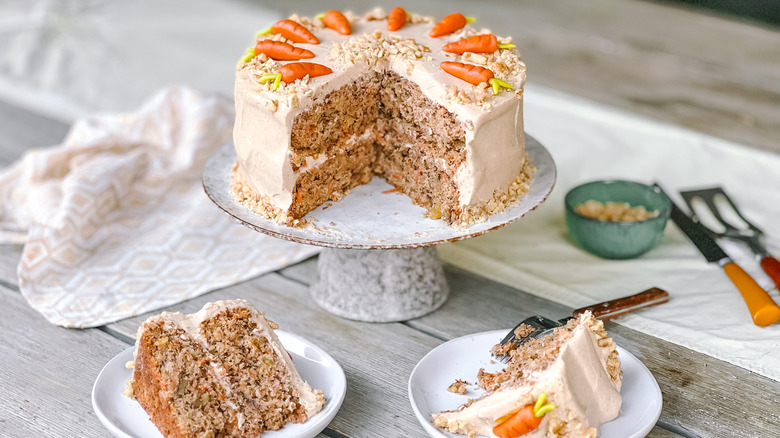
- For the frosting
- 3 cups raw whole cashews
- 3 tablespoons fresh lemon juice
- 1 tablespoon vanilla extract
- 1 teaspoon apple cider vinegar
- 1 cup canned coconut cream, well-stirred
- 2 ½ cups confectioners' sugar
- 1 tablespoon cinnamon
- ½ teaspoon salt
- ¼ cup melted virgin coconut oil, cooled
- For the cake
- 2 tablespoons ground flaxseed
- ⅓ cup warm water
- ½ cup golden raisins
- 2 ½ cups all-purpose flour
- 2 teaspoons baking powder
- 1 teaspoon baking soda
- 1 teaspoon salt
- 1 tablespoon ground cinnamon
- ½ teaspoon ground cardamom
- ½ teaspoon ground nutmeg
- ¼ teaspoon ground cloves
- ½ cup canola oil
- ½ cup unsweetened oat or almond milk
- ½ cup granulated sugar
- ½ cup light brown sugar
- 1 tablespoon vanilla extract
- 1 tablespoon apple cider vinegar
- 2 cups shredded carrots
- 1 cup crushed pineapple, drained of juice
- 1 cup finely chopped raw walnuts, plus more for garnish
- For the marzipan carrots
- 1 (7-ounce) roll of marzipan
- Red, yellow, and green plant-based food coloring
- ⅛ teaspoon cinnamon
- Start the frosting 1 day in advance by placing the cashews in a large, heat-proof bowl and covering with hot water. Cover and soak the cashews for at least 8 hours and up to overnight.
- Drain and rinse the cashews.
- Transfer the cashews to a high-speed blender or food processor along with the lemon juice, vanilla, and apple cider vinegar. Process until a paste forms.
- Add the coconut cream, confectioners' sugar, cinnamon, and salt. Process until completely smooth, scraping down the sides a few times (about 2 minutes total).
- With the blender running, drizzle in the melted coconut oil and process until smooth.
- Pour the frosting into a large bowl and place in the freezer for 30 minutes.
- Whisk the frosting smooth and freeze for an additional 30 minutes. Repeat the process 3 times in total.
- While you work on the frosting, preheat the oven to 350 F.
- Prepare two 8-inch round baking pans by coating the insides with baking spray and lining the bottoms with parchment circles.
- Make the cake: In a small bowl, mix the ground flaxseed and warm water. Let sit for 10 minutes, until thickened.
- In a separate, medium bowl, cover the golden raisins with hot water and plump while the flaxseed meal is sitting.
- Drain the raisins and set aside.
- In a large mixing bowl, whisk together the flour, baking powder, baking soda, salt, cinnamon, cardamom, nutmeg, and cloves.
- In another mixing bowl, whisk together the canola oil, oat milk, granulated and brown sugar, vanilla, apple cider vinegar, and flaxseed mixture until smooth.
- Stir the liquid mixture into the dry ingredients.
- Fold in the carrots, pineapple, walnuts, and plumped raisins, taking care not to overmix.
- Divide the batter evenly between the prepared pans.
- Bake the cakes for 35 minutes, or until golden brown and firm to the touch.
- Cool the cakes completely in the pans, then turn them out onto racks.
- Once the frosting has thickened and is very cold, use a hand mixer or stand mixer to whip until the frosting is light and thick.
- Place one cake layer on a plate or serving platter.
- Spoon on about ¾ cup of frosting and evenly spread it to the edges.
- Place the second cake layer on top of the frosting, bottom-side up.
- Spread on the remaining icing to cover the top and all of the sides of the cake.
- Use the additional chopped walnuts as a garnish.
- To make the marzipan carrots, add a small amount of red and yellow food coloring to a golf ball–sized piece of marzipan, and knead to create an orange dough, wearing gloves, if desired.
- Repeat the process with green food coloring and a smaller amount of marzipan to make a green dough for stems.
- Roll small balls of orange dough about the size of a hazelnut, and then form them into a carrot shape.
- Use a toothpick to create ridges in the dough and poke a hole at the top of the carrots to insert the stems.
- Roll thin pieces of the green dough into stem shapes and insert them into the holes in the carrot tops.
- Brush the carrots with a bit of cinnamon to simulate dirt.
- Place the carrots decoratively around the top of the cake as a garnish.
- Keep the cake refrigerated until ready to slice and serve.
